University Sydney Light Rail Project: Public Domain Strategy Report
VerifiedAdded on 2020/02/24
|11
|2608
|423
Report
AI Summary
This report provides a comprehensive analysis of the Sydney Light Rail Project, a collaborative initiative between HASELL and NSW to enhance Sydney's transport infrastructure. The project focuses on the integration of light rail, specifically the South East Rail Project (CSELR) and Central Business District (CBD) routes, spanning 12 kilometers and connecting key locations like Circular Quay, Kingsford, and Randwick. The report delves into the conceptual design, examining the layout, rules, and regulations, and the public domain strategy that includes the design of stops and surrounding landscapes. It also discusses the circumstantial analysis of CSELR, considering land zoning, transport connectivity, and traditional elements. The report concludes with a summary of the project's potential benefits, including improved transport and enhanced city aesthetics, alongside recommendations for online ticketing, real-time updates, and collaboration with the bus network.
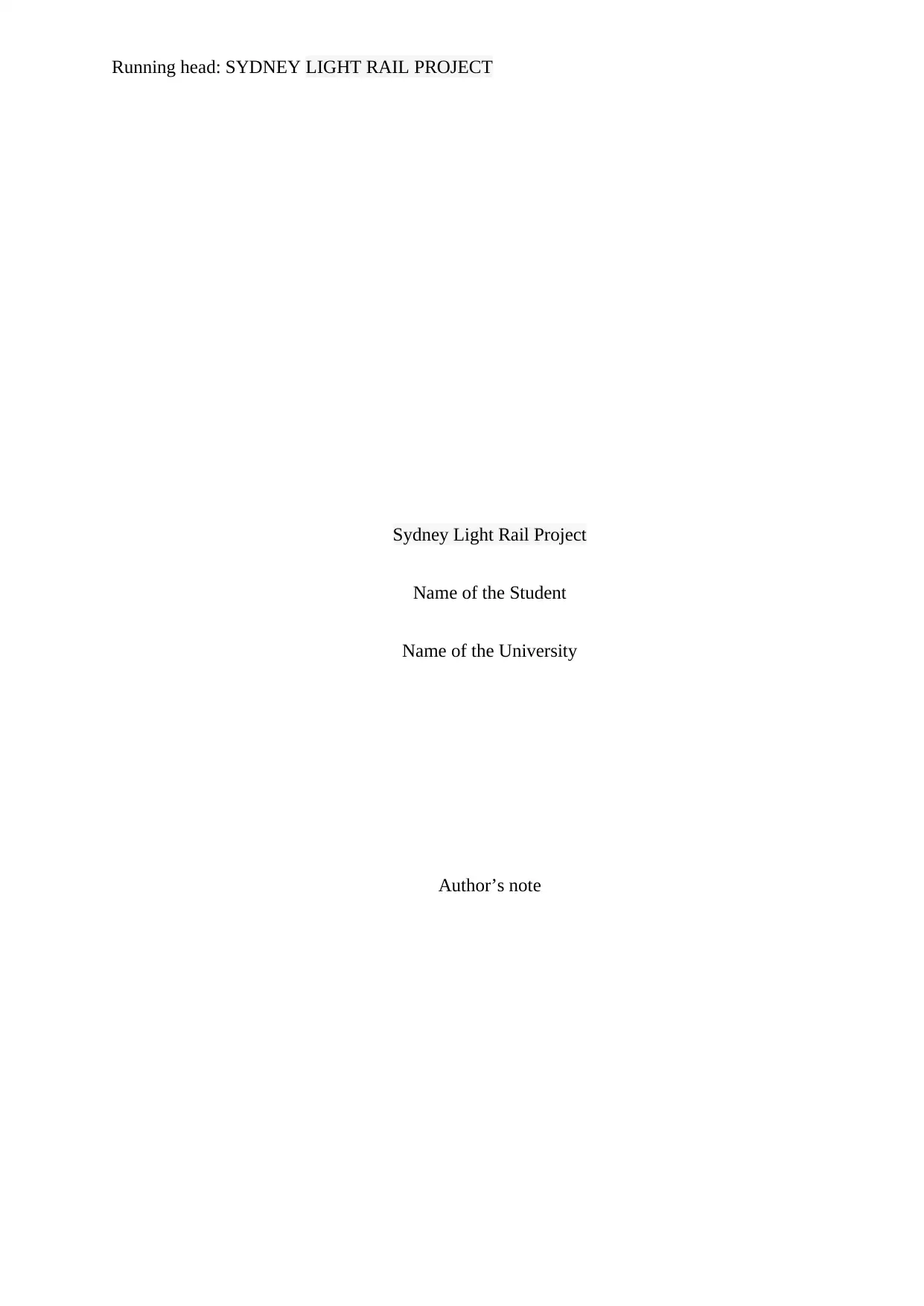
Running head: SYDNEY LIGHT RAIL PROJECT
Sydney Light Rail Project
Name of the Student
Name of the University
Author’s note
Sydney Light Rail Project
Name of the Student
Name of the University
Author’s note
Paraphrase This Document
Need a fresh take? Get an instant paraphrase of this document with our AI Paraphraser
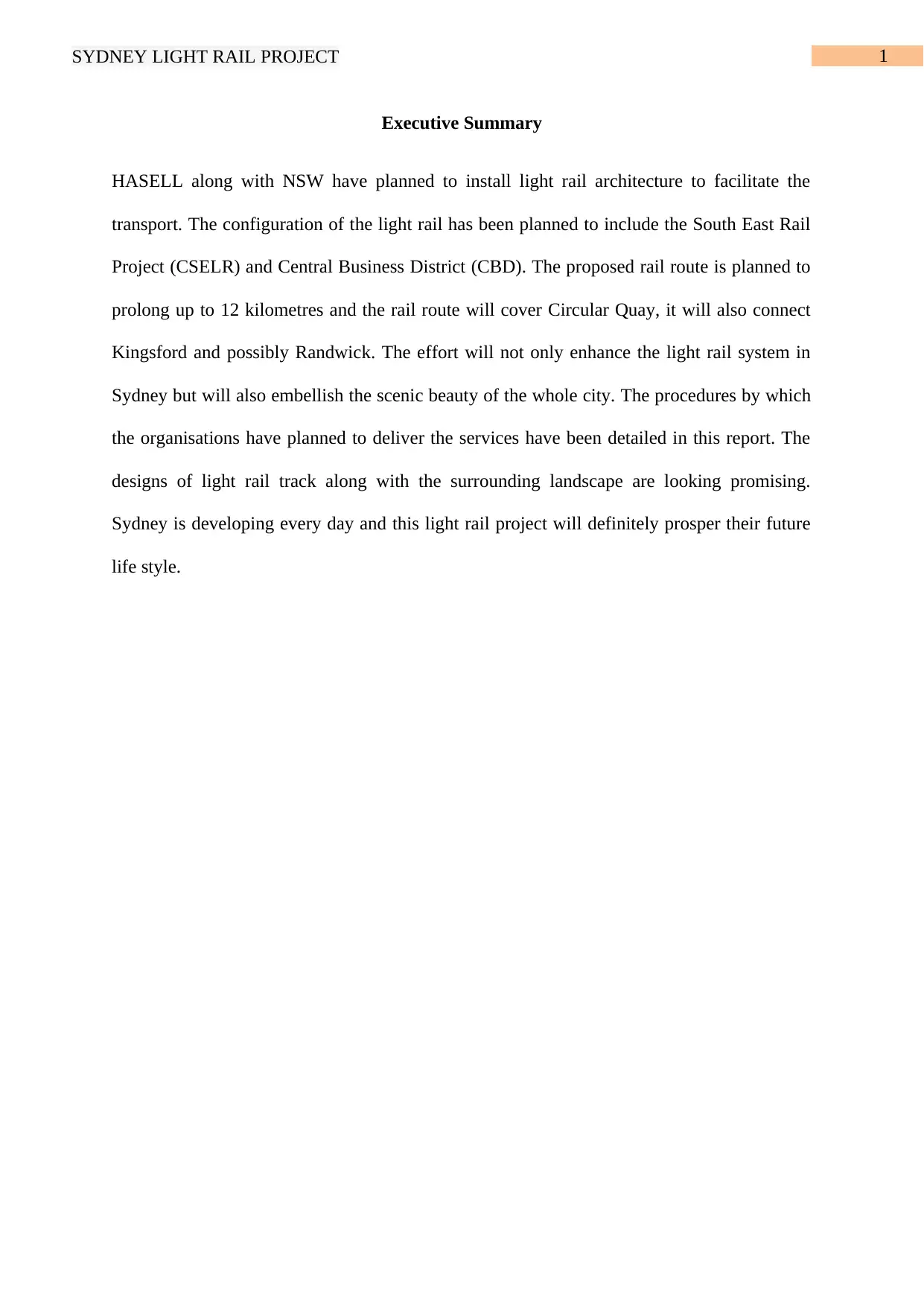
1SYDNEY LIGHT RAIL PROJECT
Executive Summary
HASELL along with NSW have planned to install light rail architecture to facilitate the
transport. The configuration of the light rail has been planned to include the South East Rail
Project (CSELR) and Central Business District (CBD). The proposed rail route is planned to
prolong up to 12 kilometres and the rail route will cover Circular Quay, it will also connect
Kingsford and possibly Randwick. The effort will not only enhance the light rail system in
Sydney but will also embellish the scenic beauty of the whole city. The procedures by which
the organisations have planned to deliver the services have been detailed in this report. The
designs of light rail track along with the surrounding landscape are looking promising.
Sydney is developing every day and this light rail project will definitely prosper their future
life style.
Executive Summary
HASELL along with NSW have planned to install light rail architecture to facilitate the
transport. The configuration of the light rail has been planned to include the South East Rail
Project (CSELR) and Central Business District (CBD). The proposed rail route is planned to
prolong up to 12 kilometres and the rail route will cover Circular Quay, it will also connect
Kingsford and possibly Randwick. The effort will not only enhance the light rail system in
Sydney but will also embellish the scenic beauty of the whole city. The procedures by which
the organisations have planned to deliver the services have been detailed in this report. The
designs of light rail track along with the surrounding landscape are looking promising.
Sydney is developing every day and this light rail project will definitely prosper their future
life style.
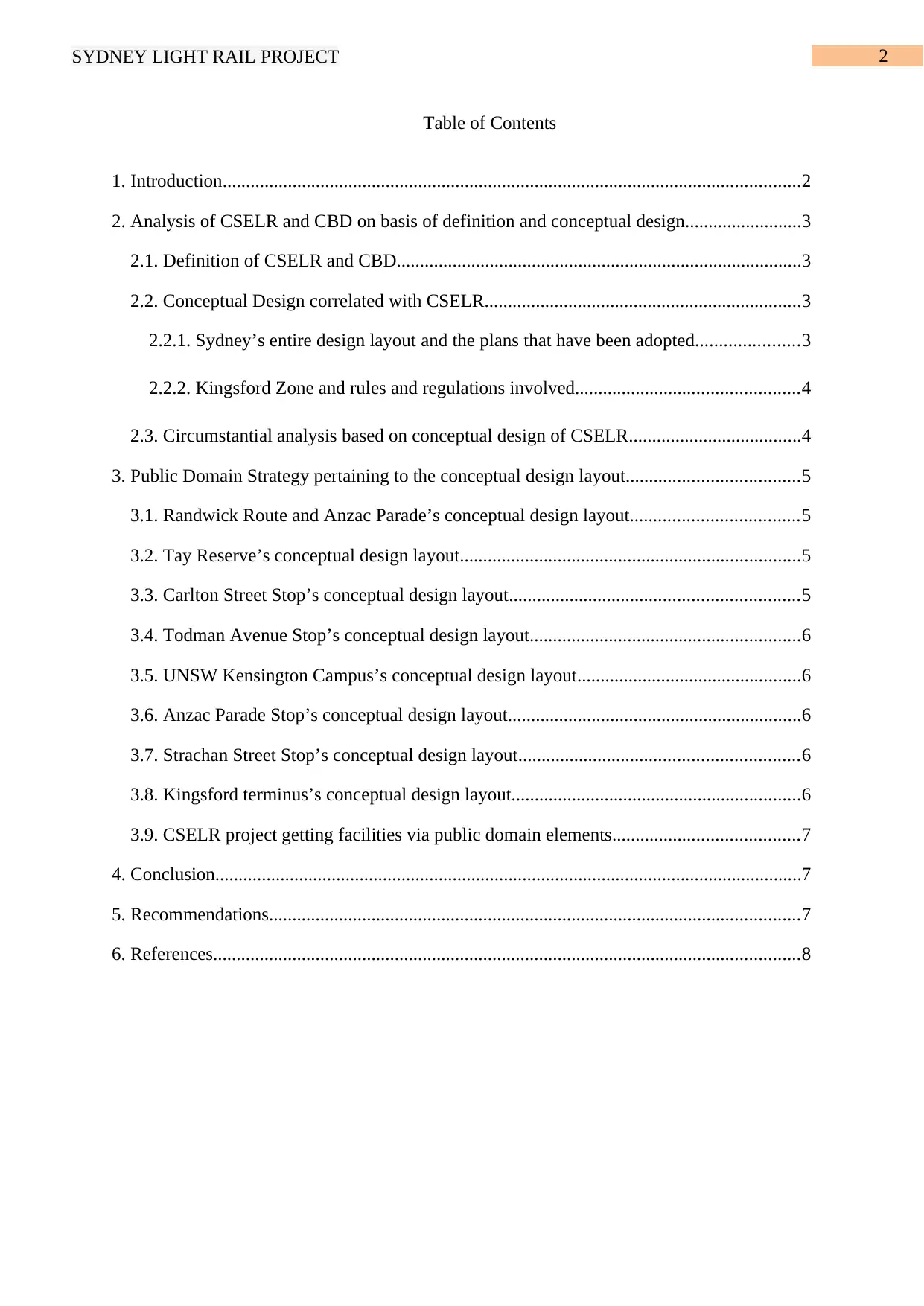
2SYDNEY LIGHT RAIL PROJECT
Table of Contents
1. Introduction............................................................................................................................2
2. Analysis of CSELR and CBD on basis of definition and conceptual design.........................3
2.1. Definition of CSELR and CBD.......................................................................................3
2.2. Conceptual Design correlated with CSELR....................................................................3
2.2.1. Sydney’s entire design layout and the plans that have been adopted......................3
2.2.2. Kingsford Zone and rules and regulations involved................................................4
2.3. Circumstantial analysis based on conceptual design of CSELR.....................................4
3. Public Domain Strategy pertaining to the conceptual design layout.....................................5
3.1. Randwick Route and Anzac Parade’s conceptual design layout....................................5
3.2. Tay Reserve’s conceptual design layout.........................................................................5
3.3. Carlton Street Stop’s conceptual design layout..............................................................5
3.4. Todman Avenue Stop’s conceptual design layout..........................................................6
3.5. UNSW Kensington Campus’s conceptual design layout................................................6
3.6. Anzac Parade Stop’s conceptual design layout...............................................................6
3.7. Strachan Street Stop’s conceptual design layout............................................................6
3.8. Kingsford terminus’s conceptual design layout..............................................................6
3.9. CSELR project getting facilities via public domain elements........................................7
4. Conclusion..............................................................................................................................7
5. Recommendations..................................................................................................................7
6. References..............................................................................................................................8
Table of Contents
1. Introduction............................................................................................................................2
2. Analysis of CSELR and CBD on basis of definition and conceptual design.........................3
2.1. Definition of CSELR and CBD.......................................................................................3
2.2. Conceptual Design correlated with CSELR....................................................................3
2.2.1. Sydney’s entire design layout and the plans that have been adopted......................3
2.2.2. Kingsford Zone and rules and regulations involved................................................4
2.3. Circumstantial analysis based on conceptual design of CSELR.....................................4
3. Public Domain Strategy pertaining to the conceptual design layout.....................................5
3.1. Randwick Route and Anzac Parade’s conceptual design layout....................................5
3.2. Tay Reserve’s conceptual design layout.........................................................................5
3.3. Carlton Street Stop’s conceptual design layout..............................................................5
3.4. Todman Avenue Stop’s conceptual design layout..........................................................6
3.5. UNSW Kensington Campus’s conceptual design layout................................................6
3.6. Anzac Parade Stop’s conceptual design layout...............................................................6
3.7. Strachan Street Stop’s conceptual design layout............................................................6
3.8. Kingsford terminus’s conceptual design layout..............................................................6
3.9. CSELR project getting facilities via public domain elements........................................7
4. Conclusion..............................................................................................................................7
5. Recommendations..................................................................................................................7
6. References..............................................................................................................................8
⊘ This is a preview!⊘
Do you want full access?
Subscribe today to unlock all pages.

Trusted by 1+ million students worldwide
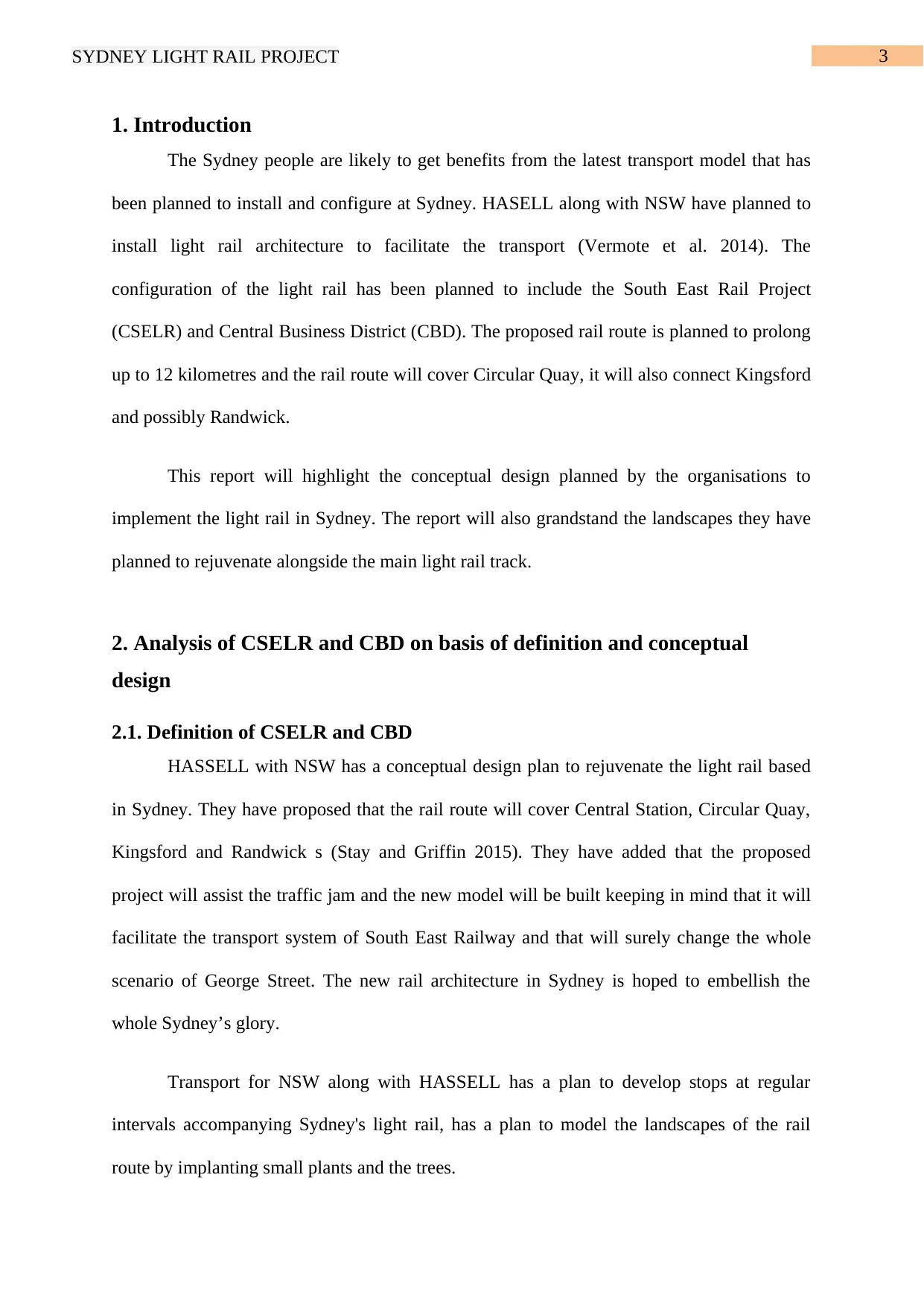
3SYDNEY LIGHT RAIL PROJECT
1. Introduction
The Sydney people are likely to get benefits from the latest transport model that has
been planned to install and configure at Sydney. HASELL along with NSW have planned to
install light rail architecture to facilitate the transport (Vermote et al. 2014). The
configuration of the light rail has been planned to include the South East Rail Project
(CSELR) and Central Business District (CBD). The proposed rail route is planned to prolong
up to 12 kilometres and the rail route will cover Circular Quay, it will also connect Kingsford
and possibly Randwick.
This report will highlight the conceptual design planned by the organisations to
implement the light rail in Sydney. The report will also grandstand the landscapes they have
planned to rejuvenate alongside the main light rail track.
2. Analysis of CSELR and CBD on basis of definition and conceptual
design
2.1. Definition of CSELR and CBD
HASSELL with NSW has a conceptual design plan to rejuvenate the light rail based
in Sydney. They have proposed that the rail route will cover Central Station, Circular Quay,
Kingsford and Randwick s (Stay and Griffin 2015). They have added that the proposed
project will assist the traffic jam and the new model will be built keeping in mind that it will
facilitate the transport system of South East Railway and that will surely change the whole
scenario of George Street. The new rail architecture in Sydney is hoped to embellish the
whole Sydney’s glory.
Transport for NSW along with HASSELL has a plan to develop stops at regular
intervals accompanying Sydney's light rail, has a plan to model the landscapes of the rail
route by implanting small plants and the trees.
1. Introduction
The Sydney people are likely to get benefits from the latest transport model that has
been planned to install and configure at Sydney. HASELL along with NSW have planned to
install light rail architecture to facilitate the transport (Vermote et al. 2014). The
configuration of the light rail has been planned to include the South East Rail Project
(CSELR) and Central Business District (CBD). The proposed rail route is planned to prolong
up to 12 kilometres and the rail route will cover Circular Quay, it will also connect Kingsford
and possibly Randwick.
This report will highlight the conceptual design planned by the organisations to
implement the light rail in Sydney. The report will also grandstand the landscapes they have
planned to rejuvenate alongside the main light rail track.
2. Analysis of CSELR and CBD on basis of definition and conceptual
design
2.1. Definition of CSELR and CBD
HASSELL with NSW has a conceptual design plan to rejuvenate the light rail based
in Sydney. They have proposed that the rail route will cover Central Station, Circular Quay,
Kingsford and Randwick s (Stay and Griffin 2015). They have added that the proposed
project will assist the traffic jam and the new model will be built keeping in mind that it will
facilitate the transport system of South East Railway and that will surely change the whole
scenario of George Street. The new rail architecture in Sydney is hoped to embellish the
whole Sydney’s glory.
Transport for NSW along with HASSELL has a plan to develop stops at regular
intervals accompanying Sydney's light rail, has a plan to model the landscapes of the rail
route by implanting small plants and the trees.
Paraphrase This Document
Need a fresh take? Get an instant paraphrase of this document with our AI Paraphraser
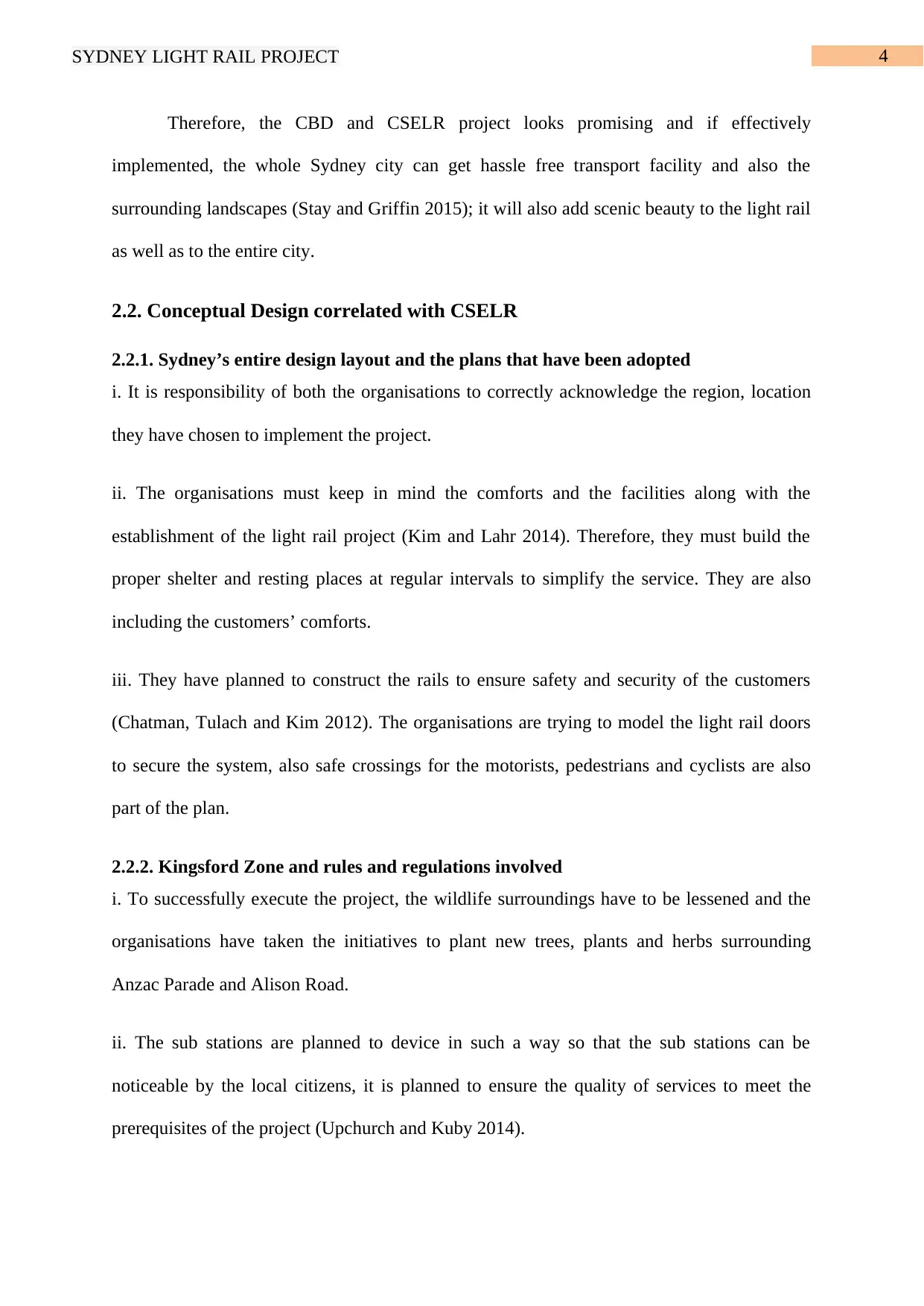
4SYDNEY LIGHT RAIL PROJECT
Therefore, the CBD and CSELR project looks promising and if effectively
implemented, the whole Sydney city can get hassle free transport facility and also the
surrounding landscapes (Stay and Griffin 2015); it will also add scenic beauty to the light rail
as well as to the entire city.
2.2. Conceptual Design correlated with CSELR
2.2.1. Sydney’s entire design layout and the plans that have been adopted
i. It is responsibility of both the organisations to correctly acknowledge the region, location
they have chosen to implement the project.
ii. The organisations must keep in mind the comforts and the facilities along with the
establishment of the light rail project (Kim and Lahr 2014). Therefore, they must build the
proper shelter and resting places at regular intervals to simplify the service. They are also
including the customers’ comforts.
iii. They have planned to construct the rails to ensure safety and security of the customers
(Chatman, Tulach and Kim 2012). The organisations are trying to model the light rail doors
to secure the system, also safe crossings for the motorists, pedestrians and cyclists are also
part of the plan.
2.2.2. Kingsford Zone and rules and regulations involved
i. To successfully execute the project, the wildlife surroundings have to be lessened and the
organisations have taken the initiatives to plant new trees, plants and herbs surrounding
Anzac Parade and Alison Road.
ii. The sub stations are planned to device in such a way so that the sub stations can be
noticeable by the local citizens, it is planned to ensure the quality of services to meet the
prerequisites of the project (Upchurch and Kuby 2014).
Therefore, the CBD and CSELR project looks promising and if effectively
implemented, the whole Sydney city can get hassle free transport facility and also the
surrounding landscapes (Stay and Griffin 2015); it will also add scenic beauty to the light rail
as well as to the entire city.
2.2. Conceptual Design correlated with CSELR
2.2.1. Sydney’s entire design layout and the plans that have been adopted
i. It is responsibility of both the organisations to correctly acknowledge the region, location
they have chosen to implement the project.
ii. The organisations must keep in mind the comforts and the facilities along with the
establishment of the light rail project (Kim and Lahr 2014). Therefore, they must build the
proper shelter and resting places at regular intervals to simplify the service. They are also
including the customers’ comforts.
iii. They have planned to construct the rails to ensure safety and security of the customers
(Chatman, Tulach and Kim 2012). The organisations are trying to model the light rail doors
to secure the system, also safe crossings for the motorists, pedestrians and cyclists are also
part of the plan.
2.2.2. Kingsford Zone and rules and regulations involved
i. To successfully execute the project, the wildlife surroundings have to be lessened and the
organisations have taken the initiatives to plant new trees, plants and herbs surrounding
Anzac Parade and Alison Road.
ii. The sub stations are planned to device in such a way so that the sub stations can be
noticeable by the local citizens, it is planned to ensure the quality of services to meet the
prerequisites of the project (Upchurch and Kuby 2014).
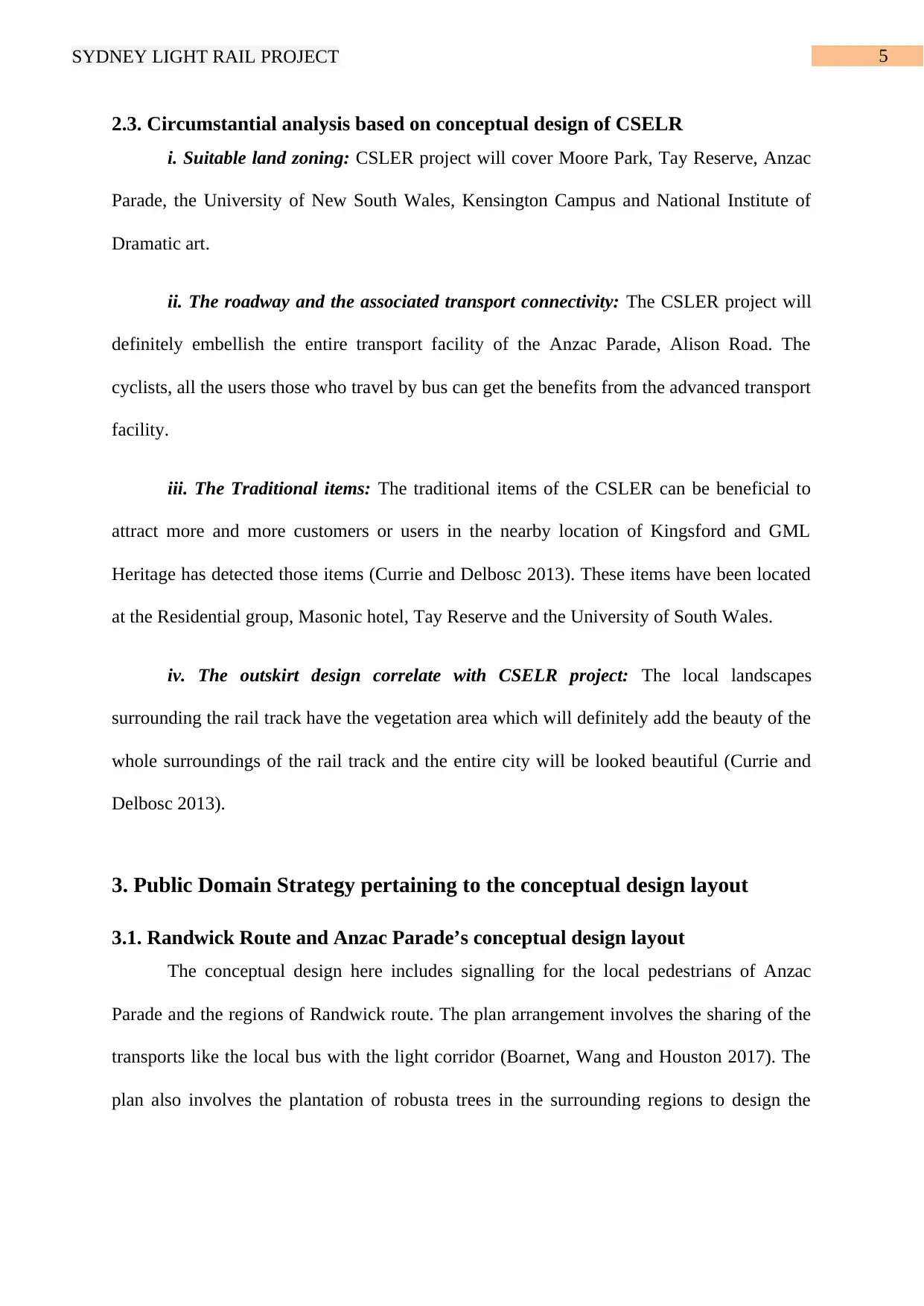
5SYDNEY LIGHT RAIL PROJECT
2.3. Circumstantial analysis based on conceptual design of CSELR
i. Suitable land zoning: CSLER project will cover Moore Park, Tay Reserve, Anzac
Parade, the University of New South Wales, Kensington Campus and National Institute of
Dramatic art.
ii. The roadway and the associated transport connectivity: The CSLER project will
definitely embellish the entire transport facility of the Anzac Parade, Alison Road. The
cyclists, all the users those who travel by bus can get the benefits from the advanced transport
facility.
iii. The Traditional items: The traditional items of the CSLER can be beneficial to
attract more and more customers or users in the nearby location of Kingsford and GML
Heritage has detected those items (Currie and Delbosc 2013). These items have been located
at the Residential group, Masonic hotel, Tay Reserve and the University of South Wales.
iv. The outskirt design correlate with CSELR project: The local landscapes
surrounding the rail track have the vegetation area which will definitely add the beauty of the
whole surroundings of the rail track and the entire city will be looked beautiful (Currie and
Delbosc 2013).
3. Public Domain Strategy pertaining to the conceptual design layout
3.1. Randwick Route and Anzac Parade’s conceptual design layout
The conceptual design here includes signalling for the local pedestrians of Anzac
Parade and the regions of Randwick route. The plan arrangement involves the sharing of the
transports like the local bus with the light corridor (Boarnet, Wang and Houston 2017). The
plan also involves the plantation of robusta trees in the surrounding regions to design the
2.3. Circumstantial analysis based on conceptual design of CSELR
i. Suitable land zoning: CSLER project will cover Moore Park, Tay Reserve, Anzac
Parade, the University of New South Wales, Kensington Campus and National Institute of
Dramatic art.
ii. The roadway and the associated transport connectivity: The CSLER project will
definitely embellish the entire transport facility of the Anzac Parade, Alison Road. The
cyclists, all the users those who travel by bus can get the benefits from the advanced transport
facility.
iii. The Traditional items: The traditional items of the CSLER can be beneficial to
attract more and more customers or users in the nearby location of Kingsford and GML
Heritage has detected those items (Currie and Delbosc 2013). These items have been located
at the Residential group, Masonic hotel, Tay Reserve and the University of South Wales.
iv. The outskirt design correlate with CSELR project: The local landscapes
surrounding the rail track have the vegetation area which will definitely add the beauty of the
whole surroundings of the rail track and the entire city will be looked beautiful (Currie and
Delbosc 2013).
3. Public Domain Strategy pertaining to the conceptual design layout
3.1. Randwick Route and Anzac Parade’s conceptual design layout
The conceptual design here includes signalling for the local pedestrians of Anzac
Parade and the regions of Randwick route. The plan arrangement involves the sharing of the
transports like the local bus with the light corridor (Boarnet, Wang and Houston 2017). The
plan also involves the plantation of robusta trees in the surrounding regions to design the
⊘ This is a preview!⊘
Do you want full access?
Subscribe today to unlock all pages.

Trusted by 1+ million students worldwide
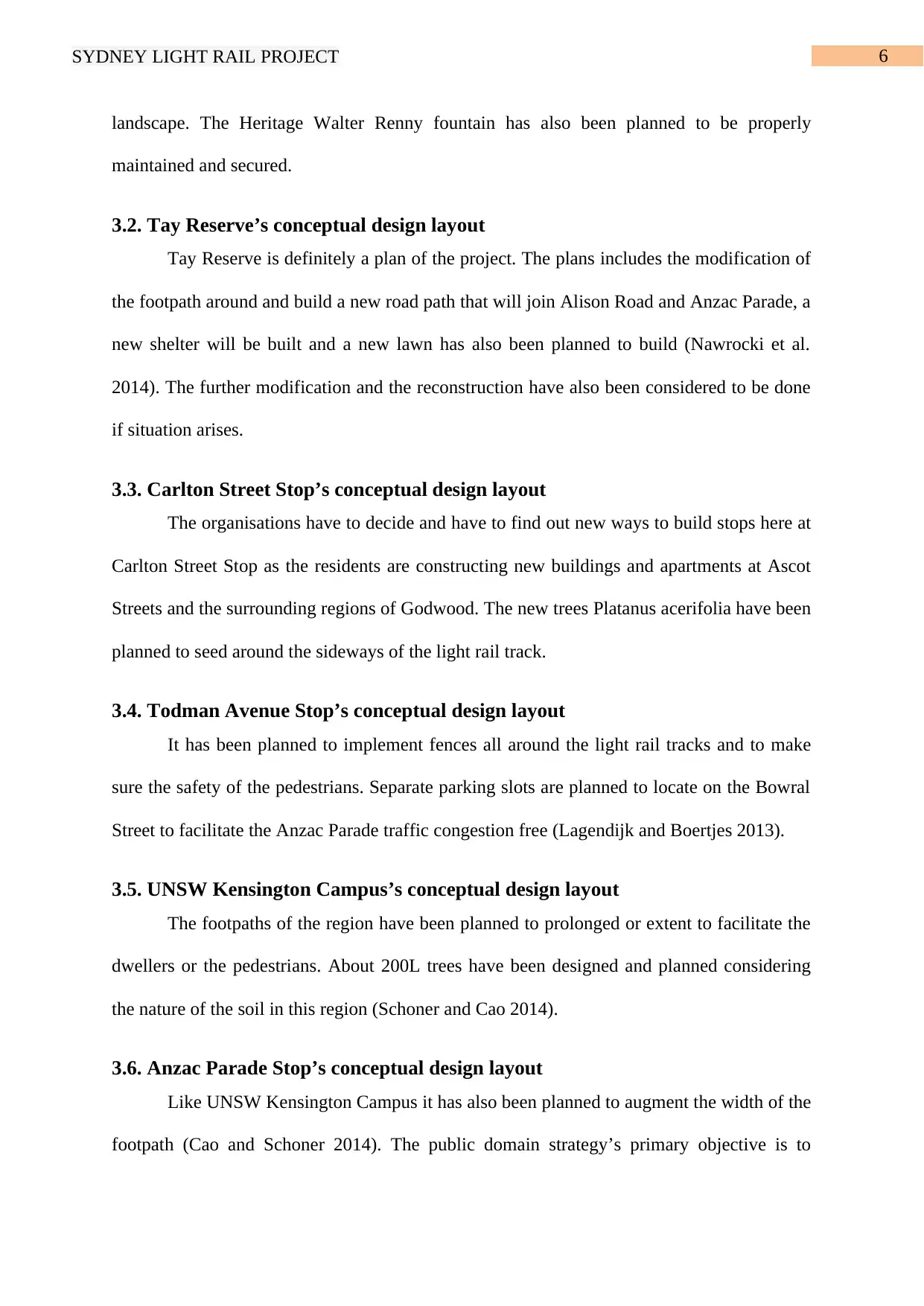
6SYDNEY LIGHT RAIL PROJECT
landscape. The Heritage Walter Renny fountain has also been planned to be properly
maintained and secured.
3.2. Tay Reserve’s conceptual design layout
Tay Reserve is definitely a plan of the project. The plans includes the modification of
the footpath around and build a new road path that will join Alison Road and Anzac Parade, a
new shelter will be built and a new lawn has also been planned to build (Nawrocki et al.
2014). The further modification and the reconstruction have also been considered to be done
if situation arises.
3.3. Carlton Street Stop’s conceptual design layout
The organisations have to decide and have to find out new ways to build stops here at
Carlton Street Stop as the residents are constructing new buildings and apartments at Ascot
Streets and the surrounding regions of Godwood. The new trees Platanus acerifolia have been
planned to seed around the sideways of the light rail track.
3.4. Todman Avenue Stop’s conceptual design layout
It has been planned to implement fences all around the light rail tracks and to make
sure the safety of the pedestrians. Separate parking slots are planned to locate on the Bowral
Street to facilitate the Anzac Parade traffic congestion free (Lagendijk and Boertjes 2013).
3.5. UNSW Kensington Campus’s conceptual design layout
The footpaths of the region have been planned to prolonged or extent to facilitate the
dwellers or the pedestrians. About 200L trees have been designed and planned considering
the nature of the soil in this region (Schoner and Cao 2014).
3.6. Anzac Parade Stop’s conceptual design layout
Like UNSW Kensington Campus it has also been planned to augment the width of the
footpath (Cao and Schoner 2014). The public domain strategy’s primary objective is to
landscape. The Heritage Walter Renny fountain has also been planned to be properly
maintained and secured.
3.2. Tay Reserve’s conceptual design layout
Tay Reserve is definitely a plan of the project. The plans includes the modification of
the footpath around and build a new road path that will join Alison Road and Anzac Parade, a
new shelter will be built and a new lawn has also been planned to build (Nawrocki et al.
2014). The further modification and the reconstruction have also been considered to be done
if situation arises.
3.3. Carlton Street Stop’s conceptual design layout
The organisations have to decide and have to find out new ways to build stops here at
Carlton Street Stop as the residents are constructing new buildings and apartments at Ascot
Streets and the surrounding regions of Godwood. The new trees Platanus acerifolia have been
planned to seed around the sideways of the light rail track.
3.4. Todman Avenue Stop’s conceptual design layout
It has been planned to implement fences all around the light rail tracks and to make
sure the safety of the pedestrians. Separate parking slots are planned to locate on the Bowral
Street to facilitate the Anzac Parade traffic congestion free (Lagendijk and Boertjes 2013).
3.5. UNSW Kensington Campus’s conceptual design layout
The footpaths of the region have been planned to prolonged or extent to facilitate the
dwellers or the pedestrians. About 200L trees have been designed and planned considering
the nature of the soil in this region (Schoner and Cao 2014).
3.6. Anzac Parade Stop’s conceptual design layout
Like UNSW Kensington Campus it has also been planned to augment the width of the
footpath (Cao and Schoner 2014). The public domain strategy’s primary objective is to
Paraphrase This Document
Need a fresh take? Get an instant paraphrase of this document with our AI Paraphraser
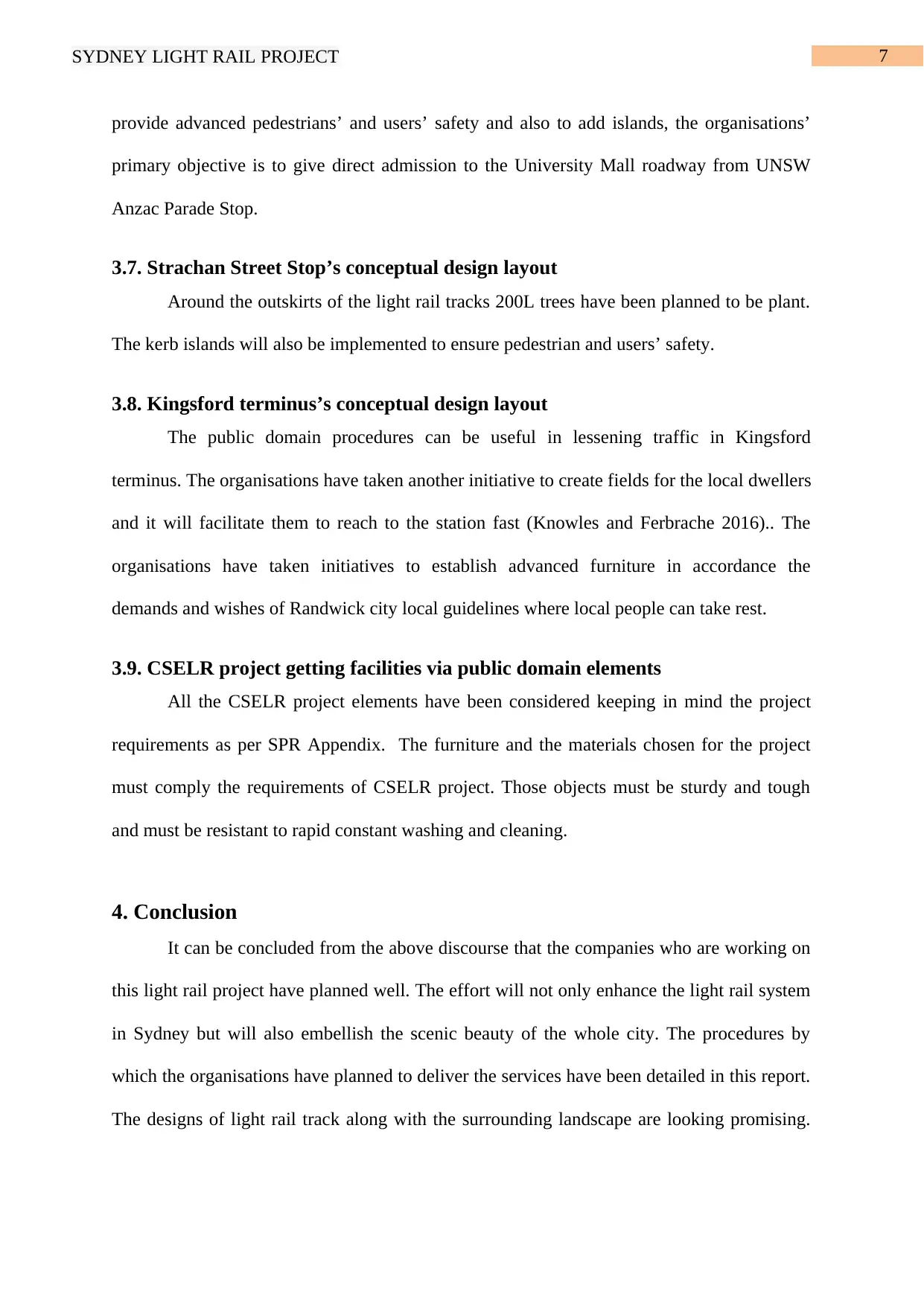
7SYDNEY LIGHT RAIL PROJECT
provide advanced pedestrians’ and users’ safety and also to add islands, the organisations’
primary objective is to give direct admission to the University Mall roadway from UNSW
Anzac Parade Stop.
3.7. Strachan Street Stop’s conceptual design layout
Around the outskirts of the light rail tracks 200L trees have been planned to be plant.
The kerb islands will also be implemented to ensure pedestrian and users’ safety.
3.8. Kingsford terminus’s conceptual design layout
The public domain procedures can be useful in lessening traffic in Kingsford
terminus. The organisations have taken another initiative to create fields for the local dwellers
and it will facilitate them to reach to the station fast (Knowles and Ferbrache 2016).. The
organisations have taken initiatives to establish advanced furniture in accordance the
demands and wishes of Randwick city local guidelines where local people can take rest.
3.9. CSELR project getting facilities via public domain elements
All the CSELR project elements have been considered keeping in mind the project
requirements as per SPR Appendix. The furniture and the materials chosen for the project
must comply the requirements of CSELR project. Those objects must be sturdy and tough
and must be resistant to rapid constant washing and cleaning.
4. Conclusion
It can be concluded from the above discourse that the companies who are working on
this light rail project have planned well. The effort will not only enhance the light rail system
in Sydney but will also embellish the scenic beauty of the whole city. The procedures by
which the organisations have planned to deliver the services have been detailed in this report.
The designs of light rail track along with the surrounding landscape are looking promising.
provide advanced pedestrians’ and users’ safety and also to add islands, the organisations’
primary objective is to give direct admission to the University Mall roadway from UNSW
Anzac Parade Stop.
3.7. Strachan Street Stop’s conceptual design layout
Around the outskirts of the light rail tracks 200L trees have been planned to be plant.
The kerb islands will also be implemented to ensure pedestrian and users’ safety.
3.8. Kingsford terminus’s conceptual design layout
The public domain procedures can be useful in lessening traffic in Kingsford
terminus. The organisations have taken another initiative to create fields for the local dwellers
and it will facilitate them to reach to the station fast (Knowles and Ferbrache 2016).. The
organisations have taken initiatives to establish advanced furniture in accordance the
demands and wishes of Randwick city local guidelines where local people can take rest.
3.9. CSELR project getting facilities via public domain elements
All the CSELR project elements have been considered keeping in mind the project
requirements as per SPR Appendix. The furniture and the materials chosen for the project
must comply the requirements of CSELR project. Those objects must be sturdy and tough
and must be resistant to rapid constant washing and cleaning.
4. Conclusion
It can be concluded from the above discourse that the companies who are working on
this light rail project have planned well. The effort will not only enhance the light rail system
in Sydney but will also embellish the scenic beauty of the whole city. The procedures by
which the organisations have planned to deliver the services have been detailed in this report.
The designs of light rail track along with the surrounding landscape are looking promising.
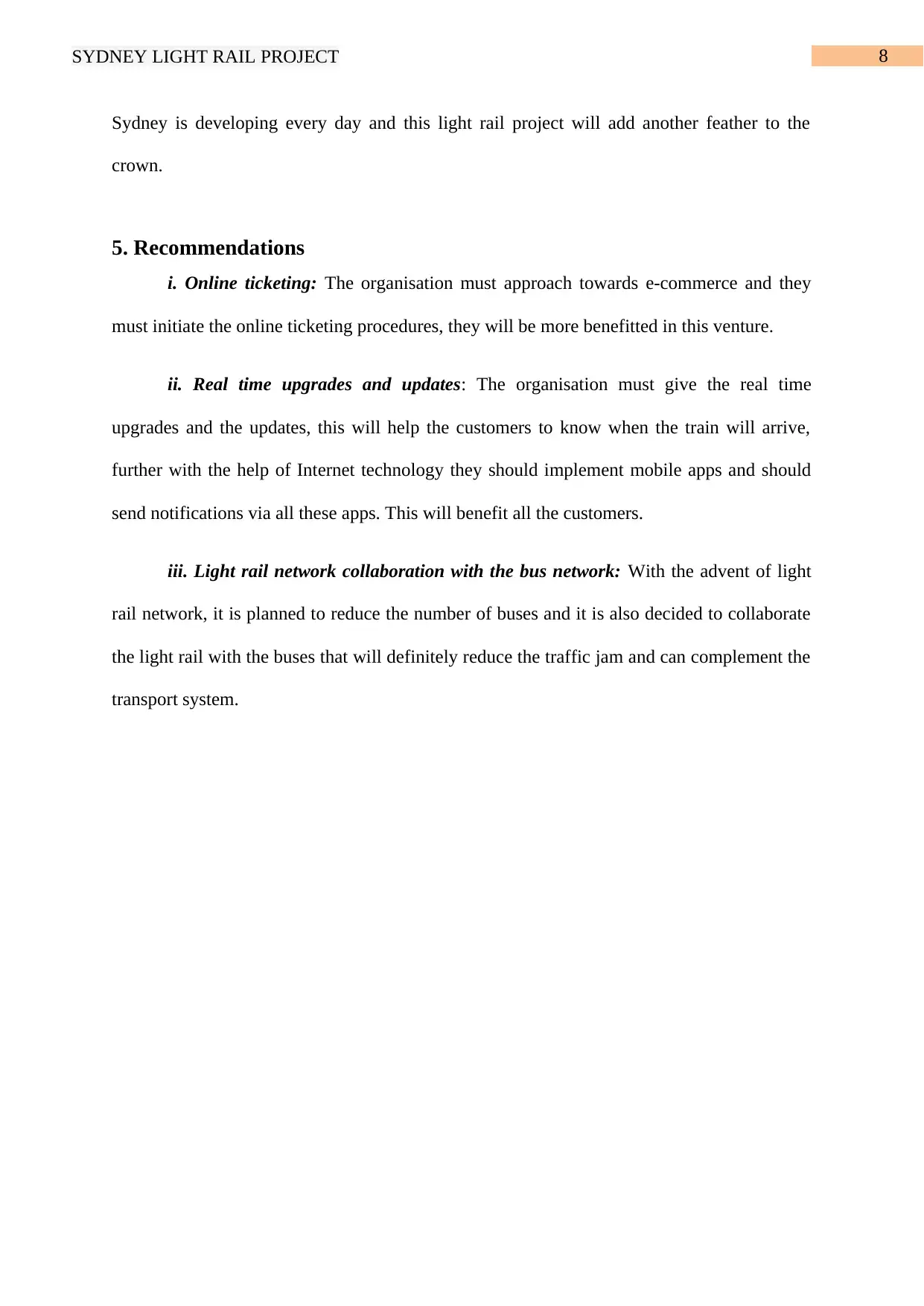
8SYDNEY LIGHT RAIL PROJECT
Sydney is developing every day and this light rail project will add another feather to the
crown.
5. Recommendations
i. Online ticketing: The organisation must approach towards e-commerce and they
must initiate the online ticketing procedures, they will be more benefitted in this venture.
ii. Real time upgrades and updates: The organisation must give the real time
upgrades and the updates, this will help the customers to know when the train will arrive,
further with the help of Internet technology they should implement mobile apps and should
send notifications via all these apps. This will benefit all the customers.
iii. Light rail network collaboration with the bus network: With the advent of light
rail network, it is planned to reduce the number of buses and it is also decided to collaborate
the light rail with the buses that will definitely reduce the traffic jam and can complement the
transport system.
Sydney is developing every day and this light rail project will add another feather to the
crown.
5. Recommendations
i. Online ticketing: The organisation must approach towards e-commerce and they
must initiate the online ticketing procedures, they will be more benefitted in this venture.
ii. Real time upgrades and updates: The organisation must give the real time
upgrades and the updates, this will help the customers to know when the train will arrive,
further with the help of Internet technology they should implement mobile apps and should
send notifications via all these apps. This will benefit all the customers.
iii. Light rail network collaboration with the bus network: With the advent of light
rail network, it is planned to reduce the number of buses and it is also decided to collaborate
the light rail with the buses that will definitely reduce the traffic jam and can complement the
transport system.
⊘ This is a preview!⊘
Do you want full access?
Subscribe today to unlock all pages.

Trusted by 1+ million students worldwide
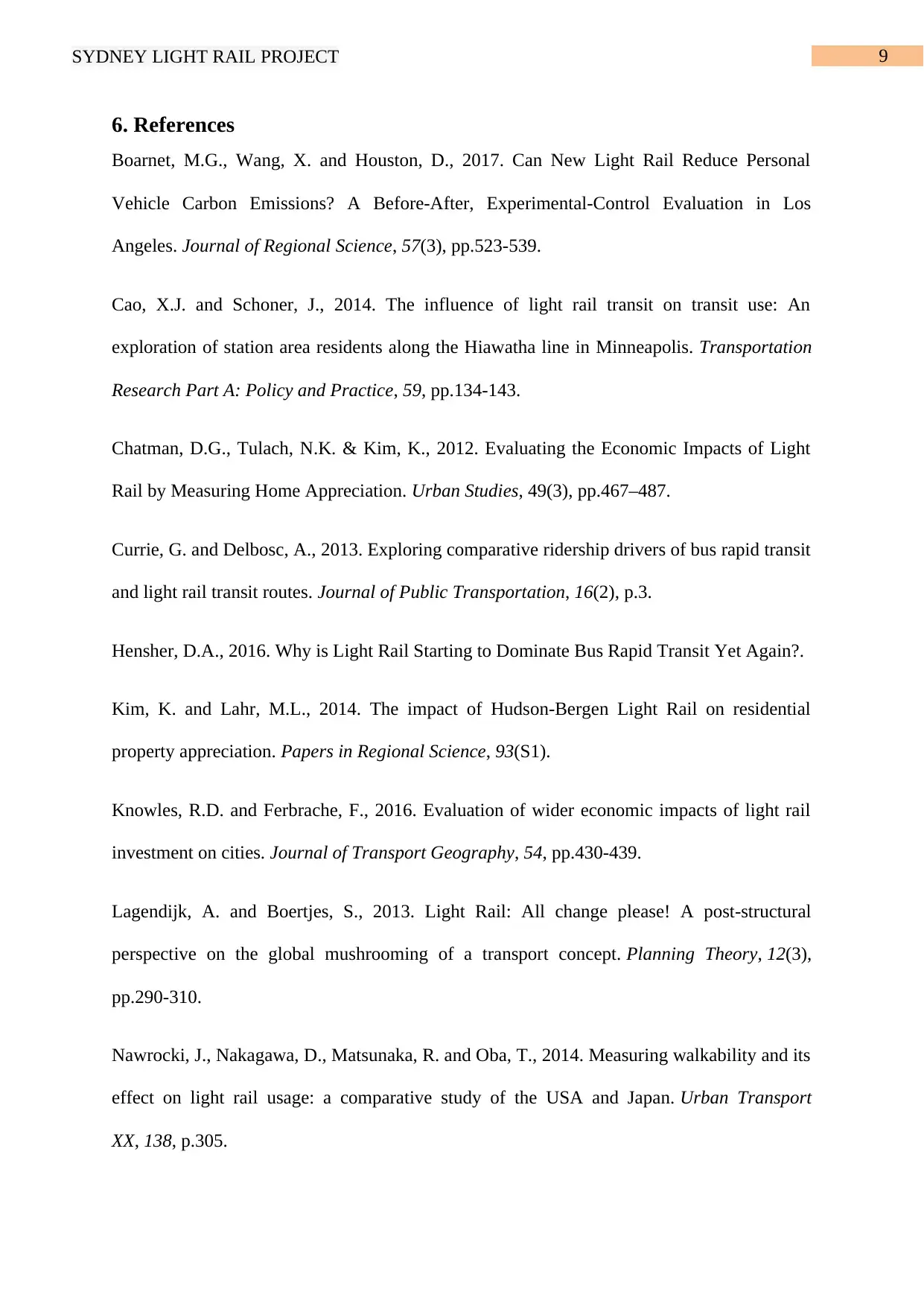
9SYDNEY LIGHT RAIL PROJECT
6. References
Boarnet, M.G., Wang, X. and Houston, D., 2017. Can New Light Rail Reduce Personal
Vehicle Carbon Emissions? A Before‐After, Experimental‐Control Evaluation in Los
Angeles. Journal of Regional Science, 57(3), pp.523-539.
Cao, X.J. and Schoner, J., 2014. The influence of light rail transit on transit use: An
exploration of station area residents along the Hiawatha line in Minneapolis. Transportation
Research Part A: Policy and Practice, 59, pp.134-143.
Chatman, D.G., Tulach, N.K. & Kim, K., 2012. Evaluating the Economic Impacts of Light
Rail by Measuring Home Appreciation. Urban Studies, 49(3), pp.467–487.
Currie, G. and Delbosc, A., 2013. Exploring comparative ridership drivers of bus rapid transit
and light rail transit routes. Journal of Public Transportation, 16(2), p.3.
Hensher, D.A., 2016. Why is Light Rail Starting to Dominate Bus Rapid Transit Yet Again?.
Kim, K. and Lahr, M.L., 2014. The impact of Hudson‐Bergen Light Rail on residential
property appreciation. Papers in Regional Science, 93(S1).
Knowles, R.D. and Ferbrache, F., 2016. Evaluation of wider economic impacts of light rail
investment on cities. Journal of Transport Geography, 54, pp.430-439.
Lagendijk, A. and Boertjes, S., 2013. Light Rail: All change please! A post-structural
perspective on the global mushrooming of a transport concept. Planning Theory, 12(3),
pp.290-310.
Nawrocki, J., Nakagawa, D., Matsunaka, R. and Oba, T., 2014. Measuring walkability and its
effect on light rail usage: a comparative study of the USA and Japan. Urban Transport
XX, 138, p.305.
6. References
Boarnet, M.G., Wang, X. and Houston, D., 2017. Can New Light Rail Reduce Personal
Vehicle Carbon Emissions? A Before‐After, Experimental‐Control Evaluation in Los
Angeles. Journal of Regional Science, 57(3), pp.523-539.
Cao, X.J. and Schoner, J., 2014. The influence of light rail transit on transit use: An
exploration of station area residents along the Hiawatha line in Minneapolis. Transportation
Research Part A: Policy and Practice, 59, pp.134-143.
Chatman, D.G., Tulach, N.K. & Kim, K., 2012. Evaluating the Economic Impacts of Light
Rail by Measuring Home Appreciation. Urban Studies, 49(3), pp.467–487.
Currie, G. and Delbosc, A., 2013. Exploring comparative ridership drivers of bus rapid transit
and light rail transit routes. Journal of Public Transportation, 16(2), p.3.
Hensher, D.A., 2016. Why is Light Rail Starting to Dominate Bus Rapid Transit Yet Again?.
Kim, K. and Lahr, M.L., 2014. The impact of Hudson‐Bergen Light Rail on residential
property appreciation. Papers in Regional Science, 93(S1).
Knowles, R.D. and Ferbrache, F., 2016. Evaluation of wider economic impacts of light rail
investment on cities. Journal of Transport Geography, 54, pp.430-439.
Lagendijk, A. and Boertjes, S., 2013. Light Rail: All change please! A post-structural
perspective on the global mushrooming of a transport concept. Planning Theory, 12(3),
pp.290-310.
Nawrocki, J., Nakagawa, D., Matsunaka, R. and Oba, T., 2014. Measuring walkability and its
effect on light rail usage: a comparative study of the USA and Japan. Urban Transport
XX, 138, p.305.
Paraphrase This Document
Need a fresh take? Get an instant paraphrase of this document with our AI Paraphraser
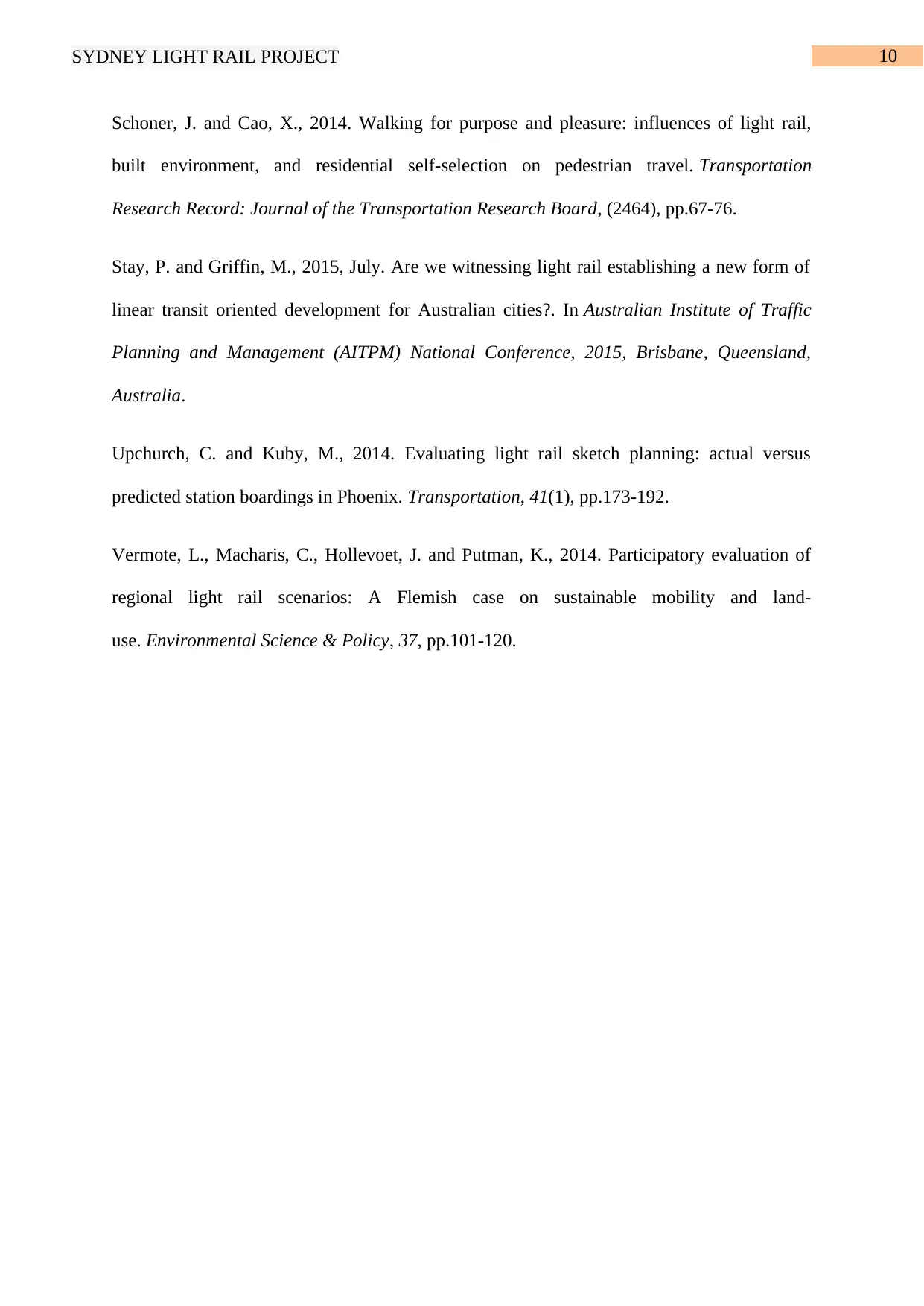
10SYDNEY LIGHT RAIL PROJECT
Schoner, J. and Cao, X., 2014. Walking for purpose and pleasure: influences of light rail,
built environment, and residential self-selection on pedestrian travel. Transportation
Research Record: Journal of the Transportation Research Board, (2464), pp.67-76.
Stay, P. and Griffin, M., 2015, July. Are we witnessing light rail establishing a new form of
linear transit oriented development for Australian cities?. In Australian Institute of Traffic
Planning and Management (AITPM) National Conference, 2015, Brisbane, Queensland,
Australia.
Upchurch, C. and Kuby, M., 2014. Evaluating light rail sketch planning: actual versus
predicted station boardings in Phoenix. Transportation, 41(1), pp.173-192.
Vermote, L., Macharis, C., Hollevoet, J. and Putman, K., 2014. Participatory evaluation of
regional light rail scenarios: A Flemish case on sustainable mobility and land-
use. Environmental Science & Policy, 37, pp.101-120.
Schoner, J. and Cao, X., 2014. Walking for purpose and pleasure: influences of light rail,
built environment, and residential self-selection on pedestrian travel. Transportation
Research Record: Journal of the Transportation Research Board, (2464), pp.67-76.
Stay, P. and Griffin, M., 2015, July. Are we witnessing light rail establishing a new form of
linear transit oriented development for Australian cities?. In Australian Institute of Traffic
Planning and Management (AITPM) National Conference, 2015, Brisbane, Queensland,
Australia.
Upchurch, C. and Kuby, M., 2014. Evaluating light rail sketch planning: actual versus
predicted station boardings in Phoenix. Transportation, 41(1), pp.173-192.
Vermote, L., Macharis, C., Hollevoet, J. and Putman, K., 2014. Participatory evaluation of
regional light rail scenarios: A Flemish case on sustainable mobility and land-
use. Environmental Science & Policy, 37, pp.101-120.
1 out of 11
Your All-in-One AI-Powered Toolkit for Academic Success.
+13062052269
info@desklib.com
Available 24*7 on WhatsApp / Email
![[object Object]](/_next/static/media/star-bottom.7253800d.svg)
Unlock your academic potential
Copyright © 2020–2025 A2Z Services. All Rights Reserved. Developed and managed by ZUCOL.

![Project Management Fundamentals and Practices Report - [University]](/_next/image/?url=https%3A%2F%2Fdesklib.com%2Fmedia%2Fimages%2Ffn%2Fcc45fac9bb8e435ca795906f2caf1048.jpg&w=256&q=75)
